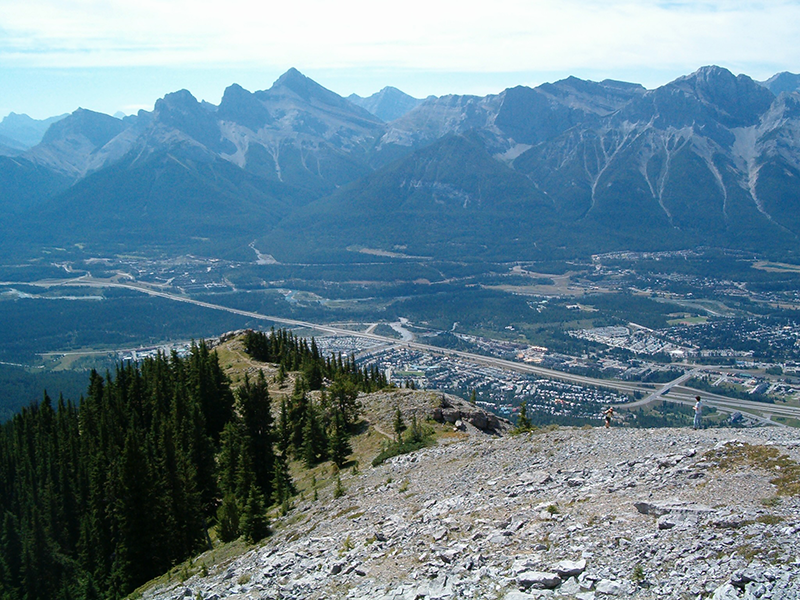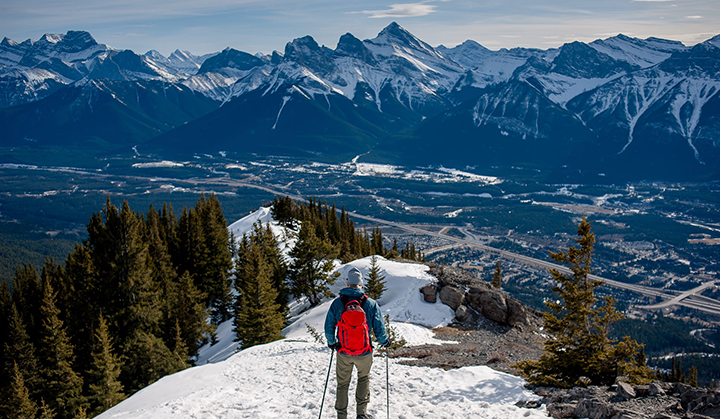3 considerations for an adequate environmental impact assessment that prioritizes wildlife movement, community
The trail up Mount Lady MacDonald, one of the most popular hikes in the Canadian Rockies, provides stunning views of the Bow River valley in Alberta.
This is a landscape deeply connected to the history and culture of the Wesley, Chiniki and Bearspaw of the Ĩyãħé (Stoney) Nakoda, Tsuut’ina, the Siksika, Piikani and Kainai Nations of the Niitsítapi (Blackfoot Confederacy), and the Métis Nation of Alberta.
The Bow Valley is also a major wildlife corridor between the protected areas of Kananaskis Country and Banff National Park, and one of the most important east-west connectors in all of the Yellowstone to Yukon region. Wildlife — from deer, elk, and bighorn sheep, to wolves, cougars and grizzly bears — call this region home alongside a growing community of people.
Every effort must be made to ensure we protect the landscapes that provide habitat and safe travel for wildlife, especially as they adapt to the impacts of a changing climate.
A hike up Mount Lady MacDonald, known as “Lady Mac” to some, also provides a birds-eye view of highways and rail lines, the town of Canmore, expanding residential development, golf courses and hundreds of kilometers of trails.
Now, a significant new tourism development — a sightseeing gondola to Lady MacDonald’s summit ridge — has been proposed, and is set to undergo a provincially-required environmental impact assessment (EIA) process.
What makes this part of the Bow Valley so special is its wildlife, serene nature to escape to, and amazing recreation opportunities. In a valley that is already stressed, adding another potential barrier to wildlife movement compromises these values.
What’s being proposed?
The proposed Silvertip Gondola would traverse a designated habitat patch and an important wildlife corridor, connecting the valley bottom to an upper terminal on the summit ridge of Mount Lady MacDonald, via a mid-station integrated with the existing Silvertip Golf Course resort area.
The project proposal includes an area with food, beverage and retail outlets, hiking trails, a suspension bridge and viewing platforms to accommodate an anticipated 200,000 to 300,000 visitors per year.
Ninety-three per cent of the project footprint is within the Bow Valley Wildland Provincial Park, which does not permit tourism attractions such as a gondola. The current regulations associated with this provincial land designation prioritize non-motorized recreation uses and the preservation and protection of natural areas.
The gondola project has been proposed several times in recent decades. When the current version of the project came forward in early 2021, the Government of Alberta confirmed that it was inconsistent with the current land management direction set forth under the Wildland Provincial Park protected area designation, as well as the provisions of the South Saskatchewan Regional Plan.
Y2Y’s concerns and considerations
To ensure the environmental impact assessment phase of the proposed gondola advances the best possible conservation outcomes for the Bow Valley to the benefit of both people and nature, these are some of the considerations we’re thinking about.
1. The Bow Valley is already pressured by human activity
The Bow Valley’s ecosystems and wildlife have long been at a crossroads. As far back as 1996, the Banff-Bow Valley Study concluded that the region was on a path that would erode the very values for which it was known and loved by residents and visitors alike.
Fast-forward to 2022, when researchers published a study based on 20 years of wolf and grizzly bear movement data and concluded that the Bow Valley has already lost up to 85 per cent of its best wildlife habitat.
Adding to that research is a soon to be released report from Y2Y and the ALCES Group on a cumulative effects modeling project for the Bow Valley. This unique work looked at past, present and future human impacts on grizzly bears. The report clearly shows how grizzly bear movement paths have already been dramatically altered. Carefully-planned development and well-managed recreation are critical to mitigate further habitat reduction and the risk of human-wildlife conflict.
For decades, every time a new development proposal comes along, we again ask: Is this the tipping point? Is this the project that will finally make it impossible for grizzly bears and other wildlife to survive here?
With so many pressures on the Bow Valley, every planning decision must be made with an understanding of overall cumulative effects. Otherwise, we risk losing what makes this area so special in the first place: the wild animals that have always been here.

2. This is our shot to get the environmental impact assessment right for nature
It is of critical importance that the environmental assessment for a proposed gondola in Canmore is done right — for nature — the first time around.
The current Terms of Reference, or scope, for the project’s EIA come from a standardized government template. This generic approach does not address the current realities of the Bow Valley as a continentally-significant wildlife corridor already challenged by significant human-induced pressures from development, tourism, recreation and industry.
To best meet the needs of the communities of wildlife and people in the Bow Valley, the EIA for the proposed gondola should:
- Look in detail at how the intent and impacts from this project intersect with existing and future development across the Bow Valley
- Be backed up by recent science that clearly quantifies historic, present and future impacts of development on wildlife movement
- Outline how all Treaty 7 First Nations will be provided the opportunity to engage fully
- Define how the project meets current laws, regional plans, strategies, and other guidelines
- Provide more clarity around human safety requirements in this risky alpine environment
- Expand on a monitoring & mitigation plan for impacts to humans and wildlife
3. The project should acknowledge community values
People who live in Canmore and the Bow Valley are committed to coexisting with the wildlife that live in and move through this corridor. This aligns with the communities’ respect for the mountains, forests and rivers where we are fortunate to live, work and play.
Time and time again, people in the community have spoken out for development plans that prioritize and ensure the health of this mountain landscape. Town planning documents clearly reflect these values of acknowledging and working within the limits of geography and ecological capacity.
Wildlife and mountain landscapes are also a primary reason that visitors come to Canmore and the Rockies. The Tourism Canmore-Kananaskis strategic plan highlights the region as one with a respect for the environment and celebrating an authentic mountain lifestyle. Environmental sustainability was cited as the number one priority during public engagement in developing the tourism strategy.
As we think about projects like the Silvertip Gondola proposal, we need to ensure that any socio-economic components of an EIA process are structured to reflect the values of the community.
What’s next?
Y2Y submitted its comments on the Terms of Reference for the EIA phase of the project to help ensure that, should the project proceed, it is to the benefit of the Bow Valley’s landscapes, wildlife and community values.
Once the EIA is complete, the Natural Resources Conservation Board (NRCB) will assess the project to determine if it is in the public interest. We will keep you posted on opportunities for future public input.
You can also sign up to receive project updates directly from the NRCB.
There’s no second chance for wildlife
As one of the most important places for wildlife in the entire Yellowstone to Yukon region, the Bow Valley deserves rigorous environmental assessments for development proposals that reflect the best science and needs of this place. If this project is to proceed, we need to get it right. There’s no second chance for this valley.
Every effort must be made to ensure we protect the landscapes that provide habitat and safe travel for wildlife, especially as they adapt to the impacts of a changing climate.
What will future generations see from atop Mount Lady MacDonald’s beautiful ridgeline? The decisions we make today can help ensure that we can still look out upon a valley where grizzly bears, elk, wolves, deer, and bighorn sheep live, and where we all benefit from the protection of these special mountain places.


